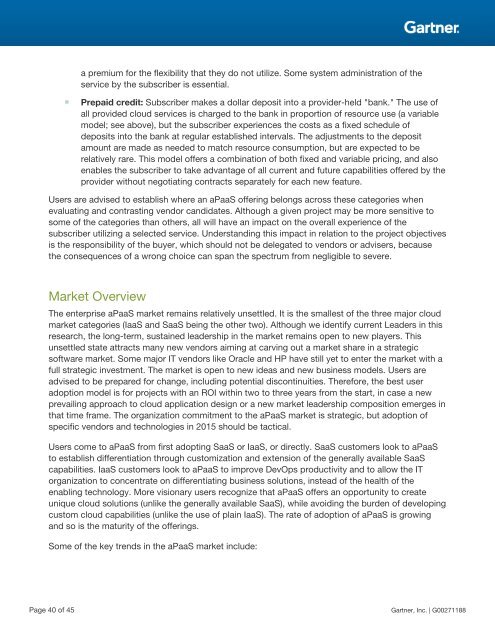Magic Quadrant for Enterprise Application Platform as a Service, Worldwide
Create successful ePaper yourself
Turn your PDF publications into a flip-book with our unique Google optimized e-Paper software.
a premium <strong>for</strong> the flexibility that they do not utilize. Some system administration of the<br />
service by the subscriber is essential.<br />
■<br />
Prepaid credit: Subscriber makes a dollar deposit into a provider-held "bank." The use of<br />
all provided cloud services is charged to the bank in proportion of resource use (a variable<br />
model; see above), but the subscriber experiences the costs <strong>as</strong> a fixed schedule of<br />
deposits into the bank at regular established intervals. The adjustments to the deposit<br />
amount are made <strong>as</strong> needed to match resource consumption, but are expected to be<br />
relatively rare. This model offers a combination of both fixed and variable pricing, and also<br />
enables the subscriber to take advantage of all current and future capabilities offered by the<br />
provider without negotiating contracts separately <strong>for</strong> each new feature.<br />
Users are advised to establish where an aPaaS offering belongs across these categories when<br />
evaluating and contr<strong>as</strong>ting vendor candidates. Although a given project may be more sensitive to<br />
some of the categories than others, all will have an impact on the overall experience of the<br />
subscriber utilizing a selected service. Understanding this impact in relation to the project objectives<br />
is the responsibility of the buyer, which should not be delegated to vendors or advisers, because<br />
the consequences of a wrong choice can span the spectrum from negligible to severe.<br />
Market Overview<br />
The enterprise aPaaS market remains relatively unsettled. It is the smallest of the three major cloud<br />
market categories (IaaS and SaaS being the other two). Although we identify current Leaders in this<br />
research, the long-term, sustained leadership in the market remains open to new players. This<br />
unsettled state attracts many new vendors aiming at carving out a market share in a strategic<br />
software market. Some major IT vendors like Oracle and HP have still yet to enter the market with a<br />
full strategic investment. The market is open to new ide<strong>as</strong> and new business models. Users are<br />
advised to be prepared <strong>for</strong> change, including potential discontinuities. There<strong>for</strong>e, the best user<br />
adoption model is <strong>for</strong> projects with an ROI within two to three years from the start, in c<strong>as</strong>e a new<br />
prevailing approach to cloud application design or a new market leadership composition emerges in<br />
that time frame. The organization commitment to the aPaaS market is strategic, but adoption of<br />
specific vendors and technologies in 2015 should be tactical.<br />
Users come to aPaaS from first adopting SaaS or IaaS, or directly. SaaS customers look to aPaaS<br />
to establish differentiation through customization and extension of the generally available SaaS<br />
capabilities. IaaS customers look to aPaaS to improve DevOps productivity and to allow the IT<br />
organization to concentrate on differentiating business solutions, instead of the health of the<br />
enabling technology. More visionary users recognize that aPaaS offers an opportunity to create<br />
unique cloud solutions (unlike the generally available SaaS), while avoiding the burden of developing<br />
custom cloud capabilities (unlike the use of plain IaaS). The rate of adoption of aPaaS is growing<br />
and so is the maturity of the offerings.<br />
Some of the key trends in the aPaaS market include:<br />
Page 40 of 45<br />
Gartner, Inc. | G00271188



